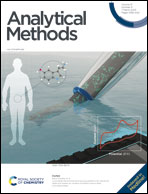Online regeneration of a piezoelectric and impedimetric immunosensor for the detection of C-reactive protein on the oriented antibody gold surface†
Abstract
Cardiovascular diseases (CVDs) refer to diseases that affect the heart and blood vessels. CVDs are considered silent killers, which are fatal (death occurs abruptly) particularly when their diagnosis is delayed. Among the biomarkers related to cardiovascular diseases, C-reactive protein (CRP) is expressed or found in high concentrations during a cardiac event. Therefore, CRP is an excellent biomarker to diagnose cardiac events, and therefore quantitative monitoring of CRP is necessary. Herein, we report the fabrication of an immunosensor for the detection and monitoring of CRP. The anti-CRP monoclonal antibody (anti-CRP-mAb), which is specific to the CRP antigen, was immobilized on the surface of gold pre-modified with 4-mercaptophenyl boronic acid (MPBA) to act as a capture antibody. The self-assembled monolayer (SAM) of 4-mercaptophenyl boronic acid (4-MPBA), Au-MPBA, was used for the oriented immobilization of anti-CRP-mAb for piezoelectric (mass-sensitive) and piezoelectric (impedance) measurements. Controlling the orientation of anti-CRP-mAb was crucial to eliminate false positive and negative results during sample analysis. The quartz-crystal microbalance with dissipation (QCM-D) measurements enabled us to follow the covalent immobilization of anti-CRP-mAb on AuCQC-MPBA in real-time. QCM-D was further used to follow the affinity reactions between anti-CRP-mAb and CRP and further with the anti-CRP polyclonal antibody (anti-CRP-pAb). The changes in frequency (Δf, Hz) were related to the changes in the mass (Δm, ng cm−2) of CRP up to a concentration of 0.10 μg mL−1, which is equivalent to 0.10 mg L−1. CRP was detected using the direct affinity immunoassay (anti-CRP-mAb < CRP) and also a sandwich immunoassay using anti-CRP-pAb for signal enhancement. The developed piezoelectric CRP detection protocol was translated to a gold disc electrode for electrochemical impedance spectroscopy (EIS) measurements. The limit of detection (LOD) using both methods was at the μg mL−1 or mg L−1 level. Furthermore, the developed electrode could be regenerated using acidic buffer (0.10 M HCl). The detected signal could be reproduced to within 5% relative standard deviation (% RSD) in buffer and serum samples, showing excellent selectivity and specificity toward CRP.



 Please wait while we load your content...
Please wait while we load your content...